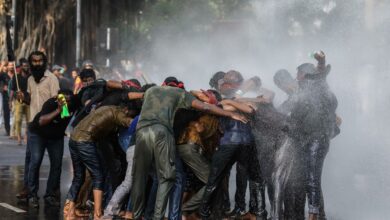Street art captures stories of war in Ukraine

By Rostyslav Averchuk
Lviv, Ukraine, Jan 30 (EFE).- Ukraine’s ongoing resistance against Russia’s invasion is being written on the walls in the form of street art while the destruction of murals in occupied regions demonstrates the country’s struggle to preserve its national and cultural identity.
The war has irrevocably changed the lives of millions of Ukrainians, many of whom have lost loved ones, their health, their jobs and their homes.
Thousands of residents of Mariupol, a city in the southeast that was almost completely destroyed by the Russian siege, have since found shelter in the western regional capital Lviv.
“We don’t really have anything to return to, with our homes burned or demolished by the Russian authorities. Still we long to get back to our beautiful city,” says Oksana Mykhailyshyn, the 20-year-old administrator of the center “I Mariupol,” which assists displaced residents of the occupied city.
A large mural stretches along the narrow street in central Lviv where the center is located.
“We wanted the locals to know more about Mariupol,” explains Oksana as she shows the painting to Efe.
“This is our theater where people were sheltering when a Russian bomb destroyed it. See, there was a sign that read ‘Children’ because we believed it could stop them from targeting it,” she adds.
Several hundred people were inside the Mariupol theater when it was bombed on March 16, 2022.
As well as the iconic buildings and the destroyed Azovstal steel plant, the mural also reflects the hopes of its author Dmytro Vovk, a young painter from Mariupol, to eventually return to his home city.
“We all hope we can come back. But it will definitely be a different place,” says Oksana.
Dmytro authored many murals and interior paintings in a city that was rapidly developing before the invasion. Many are gone now, either destroyed during the combat or demolished.
Some murals have been purposefully destroyed, such as the iconic “Milana” mural, created by the Kyiv painter Oleksandr Korban.
Located on the exterior of a high-rise building in Mariupol, it depicted the 6-year-old girl, Milana Abdurashitova, who lost a leg in the shelling of the city in January 2015. The tragedy took the lives of 29 people, including the mother of the girl.
In November, Mariupol’s mayor Petro Andriushchenko revealed that Russian authorities had destroyed the mural, citing the need to “restore the thermal insulation of the building.”
Oksana says she believes Russians are looking to erase the memories of their actions in Mariupol as well as the traces of the Ukrainian history of the city.
In addition to street art, Russian occupiers and collaborators also destroyed a monument to the victims of the 1933 Holodomor famine, a man-made famine orchestrated by the Soviet Union in which an estimated three to four million Ukrainians died.
In contrast, the streets of Ukrainian-controlled cities continue to fill with murals by both local and foreign artists.
Perhaps the best known examples include seven paintings by Banksy in the Kyiv region that depict the unexpected incursion of the war into the peaceful life of the locals, with one of them showing small children using the anti-tank hedgehog as a seesaw.
In Lviv, several paintings in the country’s flag colors, blue and yellow, were made by the French artist Christian Guémy, known as C215, who also painted in Kyiv, Bucha and Hostomel.EFE





